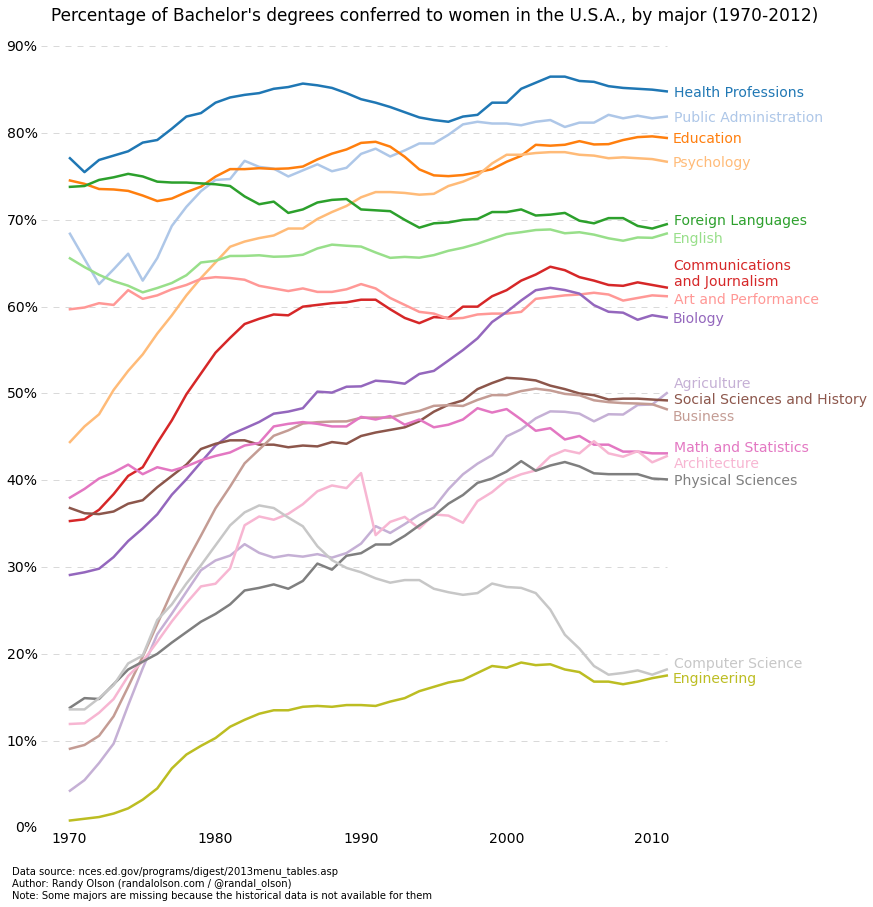No, We Don’t Need More Women in the Tech Industry
If there’s one thing that all leaders and pundits in the tech industry can agree on, it is that there aren’t enough women in the field.
As Derek Khanna pointed out in his seminal Atlantic article, women hold 57 percent of occupations in the workforce, but, in computing occupations, that figure is only 25 percent. The leadership picture is even more dismal. Of the many chief information officer jobs at Fortune 250 companies, women comprise only 20 percent. And it’s getting worse. In 1984, females were awarded 37.1 percent of computer science degrees; today they account for less than 12 percent.
If we were to listen to the popular tech writers of the day, politicians, and even a growing number of male tech leaders, this trend amounts to a great “tragedy”. As Khanna puts it, low numbers of women in tech is bad for women, bad for tech, and bad for society in general.
But can it be said that things are so terrible? The last time I checked, IT was the most expansive and innovative industry on the planet. Granted the numbers show that tech favors men, but can it be said that that is such a bad thing when it is clear that the industry is prospering so? Why is it a tragedy that only 12 percent of computer science degrees are awarded to women? Why do we need more women in tech anyway?
There are three popular arguments for why we should have more women in tech: The first is that the numbers speak for themselves—since half the population is female, so should half of the tech workforce be female. The second is that minorities (including women in tech) are at a disadvantage and are thus dissuaded from pursuing the field, so we should fill the field with women to make them more comfortable. And, the third is that we need more women in tech to provide a more balanced perspective for decision-making and quality of output.
Each of the arguments bears an instinctive egalitarian appeal. More diversity means fairness for all and ultimately higher quality work. Of course there should be more women in the field—to deny it is to admit ignorance and promote poor quality work. Who would dare such nonsense?
But with a closer look, we find that these arguments aren’t as powerful as they seem on the surface and rather point to another, more compelling reason why so many are demanding more women in tech. To examine, let’s first take a look at each of the arguments in more depth.
1. The numbers speak for themselves.
The most common argument for more women in tech goes like this: We know that we need more women in tech because the numbers speak for themselves. Women comprise half of the population and almost half of the workforce, ergo women should comprise at least half of the tech industry. Drop the mic.
Of course, this is nonsense. It is to suggest that the distribution of sexes in the population should be the primary and perhaps only precept for determining everyone’s career path. And, while it might make sense to take this into some consideration, there is no reason to think that it should be the only factor. What about skills, interests, background, education, economic concerns, and personal preferences? There can be no doubt that these factors ought to play a predominant role in occupation choice, and, when taking them into account, we can see that they might well lead to a disproportionate distribution of the sexes in any given field.
Consider if we take the 50 percent ideal to its natural extent: If we are to say that women should make up 50 percent of a given profession, then women should make up 50 percent of all professions. That includes other male-dominated fields such as car sales, trash collecting, building construction, and mechanical engineering. One will note that we don’t hear clamoring for parity in those occupations. But, if we are to use the 50 percent mark as the standard, then we should apply it to all careers. Women should also make up half of all firefighters, athletes, Catholic priests, soldiers and sailors, and, don’t forget, men’s bathroom attendants.
But that is not all. There are many professions that women dominate. In order to meet the 50 percent ideal, we would have to demand parity in those professions as well—teaching, publishing, biology, language translation, manicuring, Catholic sisterhood, fashion modeling, and women’s locker room attendance. If parity is the goal, it should be applied in across the board. The data, as they say, prove it.
And yet, we find that those people clamoring for more women in tech are not quite vocal about getting more men into publishing, nursing, or teaching. Women have a near monopoly in those fields, but no one is quite concerned about the asymmetry there. The rationale is simple: Women tend to gravitate toward those professions more than men. They tend to have skills that lend to success in those fields and their interests lead them in those directions. And, if this can be considered true for women in publishing, nursing, and teaching, it should also be considered true for men in car sales, engineering, and, yes, even computer programming.

We have forgotten the basic fact that men and women are different, and that different personalities and skills lend to different professions. Few will challenge this premise, and yet few will acknowledge it. The differences can be seen most clearly in the physical realm: Men tend to be bigger and stronger; it only makes sense that they predominate occupations such as firefighting and soldiering. Women tend to be smaller and more precise; it only makes sense that they predominate occupations such as teaching and nursing.
And this principle extends beyond physical traits and into the psychological. Men tend to have bigger brains; women’s brains contain more connections. Men’s and women’s brains react differently to given stimuli. Males tend to display thinking traits; women tend to display feeling traits.
As it is with the physical traits, it only makes sense that each would find interest in and pursue different occupations based on these psychological differences. Altogether, men tend to be more analytical and systematic, traits that work well in technology. As such, it could be that the tech industry is simply fashioned better for men. By the same token, women tend to be more people-oriented and emotional, traits that tend not to work well in technical roles. With a simple survey, it becomes clear as to why the computer sciences might not have the same number of women as men.
Now, one can debate the origin of these traits and thus the validity of their outcome. Indeed, some will argue that the differences between men and women are not innate, but rather wholly derived by society. As such, the argument is that we should change society to more equitably condition males and females for all occupations. But, if we can side with the growing majority of psychologists that claim at least some differences are innate, then we can see how those differences might lead toward different interests and ultimately different careers.
Similarly, it must be pointed out that these tendencies are viewed through the lens of generality and cannot be applied to all men and women. Some women are more logical and less emotional than the average man; some men are better caretakers and less analytical than the average woman. A brief review of history shows that women were some of the most important pioneers in the tech industry. As with all generalities, there are exceptions.

But that doesn’t mean that we can disregard the facts that most men and women display recognizable traits. We call them ‘stereotypes’ for a reason. In this regard, it is constructive to imagine a graph in which the populations of men and women are distributed in the shape of bells along the axis of a given characteristic.
Take empathy for instance. One of the most important traits for nursing is the ability to feel for the pain and suffering of patients so as to provide compassion and comfort. In a given population, both men and women will rate all over the board when it comes to this trait. But, if we measure it out, we will see two patterns emerge. First, there will be a large group in the middle of each distribution where the average resides. And, second, the averages for men and women will be displaced to some degree with the women’s bell curve shifted up the empathy scale.
For any given characteristic, the bells for men and women will be displaced to some degree with a portion overlapping. It is true that the individuals who fall in the overlapping segments will perform around the same level as those in the opposite sex. Certainly, there are excellent male nurses just as there are excellent women coders. And, for them, it makes sense that we should welcome them to engage in the profession that best fits those characteristics.
Generally speaking, however, it should not be a surprise that the vast majority of tech professionals are male, and forcing women into the field would only create an unnatural and thus inefficient and troublesome dynamic. Which leads us to the second argument for more women in tech.
2. We should have more women in tech so they won’t feel so out-of-place.
In any given social situation, anyone in a minority group will be judged, marginalized, and potentially bullied just for being different. Women encounter this in any workplace, especially when they are in the small minority of a ‘boys’ club’ environment like the tech industry. Facebook COO Sheryl Sandberg relays a story of when Speaker of the House Tip O’Neill introduced her by patting her on the head, saying she is pretty, and asking, “Are you a pom-pom girl?”
When this kind of mentality permeates a culture, the result is bound to be inequity. Men have been at the head of business and industry from time immemorial, and so have had a favored place above women who are trying to make it up the ladder. When a man is the boss, he can and, according to Sandberg, often will discriminate against an employee that doesn’t fit his vision of worker or leader. Pay discrepancies are just the most obvious signs.
As a result, those in the minority have the deck stacked against them. Not only do they have to perform at a high level for their jobs; they also have to deflect the bullying and nonsense that comes with being in the minority. Understandably, many won’t be able to take the added pressure and ultimately fail. Others will give up, figuring that it’s not worth the struggle.
It is an understandable grievance, and I think all will agree that we should jettison all bullying in all circumstances. But, let us consider how the ‘more women in tech’ movement proposes to get rid of said bullying and ostracism. Essentially, the proposed answer would be to get rid of minorities of all kinds to avoid any discomfort, a remedy that would not only be impossible, but would also be rather ineffective, and most importantly undesirable if attempted seriously.
To begin, it would be impossible. Every personality is made up of thousands of characteristics, most of which are not shared with the majority of others. To arrange a work situation so that all are represented equally would mean either stripping employees of their characteristics or reducing the workforce to one. Basically, it’s not possible to make sure that everyone is comfortable in every aspect of their person—differences are inevitable, and good workers will not be deterred by this fact.
Even if it were possible, it wouldn’t be effective. Say we focused on a single characteristic—sex—and sought to ensure parity in order for women to feel more comfortable in the tech world. This would mean filling the ranks of the tech industry with women irrespective of their interests or qualifications, just to keep their colleaguettes company. Given the naturally low numbers of women in the industry, this would mean either forcing disinterested women into the field or giving a pass to women who are not qualified to be there.

Notwithstanding the obvious implications such Affirmative Action would have on the productivity and quality of work, it must be said that such an arrangement would also be bad for morale. What kind of a signal would it send to the qualified woman if half of her coworkers were there for their gender alone? Would it put doubt in her mind that she is qualified to be there too? It is likely that such a condition would be more demoralizing than the ‘boys’ club’ bullying that the situation would otherwise engender. We saw this as far back as the 1970s in ethnic minorities feeling demeaned and otherwise out of place for their admission to universities and businesses due to Affirmative Action. There is reason to believe that the same would be true for women in tech.
Doubtless, we need understanding and open mindedness, but we don’t need to get rid of standards or merit. The latter isn’t the only way to achieve the former.
Lastly, even if it were effective, it wouldn’t be desirable. To eliminate minorities would be to eliminate key dissident perspectives that are essential to success. Ironically, this is the basis for the next and last argument for parity.
3. We need more women to provide different perspectives.
In a SXSW Interactive 2015 keynote, Lyft founder Logan Green said that we need more women in the executive ranks so that we don’t make boneheaded decisions that men often make. He has a point—when more than half of your customer base is made up of women, it is good business to take into consideration the female perspective. Find out what they want and how they operate to get their business.

And yet it is not clear that we need parity or even ‘more women’ in the industry to accomplish this. For sure, it makes sense that executives should consider the female perspective. But there are plenty of ways to do this other than filling jobs. Focus groups come in handy. And what about good old-fashioned imagination? A children’s publisher doesn’t hire children to write the books; it hires adults who can imagine what a kid wants and needs to learn. A priest does not have to be married to know how to give marriage advice. Similarly, a man does not need to think the way a woman thinks when shopping for clothes or hiring a rideshare. Using imagination, he can appreciate, predict, and possibly even understand the way a woman thinks in any number of circumstances.
To be sure, gender plays an important role in one’s perspective, but it is not the only element, and in many cases it can distract from what would otherwise be a more distinct vantage. Perspectives are rich, psychological constructs that derive from all kinds of personal experiences, gender being but one. A woman could disagree with fellow women just as easily as she could with the men in the conference room. I find myself disagreeing with just about everyone equally no matter his or her gender.
Ultimately, we should all be equal-opportunity dissenters, and the only way to achieve that is for everyone to think for him or herself. In the end, perspective is what matters, and you can’t have perspective if you’re doing whatever the status quo dictates. If someone’s perspective is so far entrenched in political correct norms that it cannot function independently from them, then that person is not really thinking anyway and can’t provide a novel perspective in the first place.
The irony in the ‘more women in tech’ movement is that proponents seek to overcome stereotypes, but in order to do that, they try to fill industry ranks with women simply because they are women and supposedly display the characteristics that make women what they are. Like all Affirmative Action efforts, the ‘more women in tech’ movement aims to overcome obstacles by emphasizing them.
True reformers know that the best way to get beyond prejudice is to let it dissolve from the public conscience. These efforts to push us past prejudices are counterproductive because they place emphasis squarely on the very issues that everybody is trying to forget.
The real reason we want more women in tech.
Ultimately, all three of the major arguments for more women in tech are logically faulty and cannot be used to support their aims. Now, the doctrinaire feminist might brush off this analysis as an attempt to hold women back and perpetuate a misogynist culture. That would be more an indictment of modern feminism than of this discourse. The feminist movement is fortified in the notion that inequality cannot mean anything other than injustice, and its supporters cannot imagine a possibility where men and women alike might benefit from their differences. We see trends like the decline in the female share of computer science degrees and assume that there must be a conspiracy afoot. Surely, the man is holding down women systematically.
And yet open-minded feminists will consider alternative explanations. When digging a little deeper, we find that indeed it is not as conspiratorial as it might seem.
Regard the trend in female computer science degrees, not in comparison with their male counterparts, but on its own. In doing so, we find that female interest in the field has remained fairly constant, and hasn’t really gone down at all. It just so happens that male interest in the field has boomed disproportionately. It’s not as though women are being pushed out, but rather that men are piling in.
As an FT Magazine writer pointed out, computer training was seen as androgynous and perhaps even more feminine in the early days due to the secretarial aspect of keyboard operation. When in the 1980s the field developed into a hobbyist haven with the personal computer, both males and females gravitated toward it, but males did more. The same happened with the advent of the Internet. It’s not that men are trying to hold women down; it’s just that men tend to be more interested in the field.
By 2012, the share of female computer science graduates had leveled off to around that of engineering graduates—seemingly a natural plateau. Taking a look at the bigger picture, we see a less controversial and yet more compelling story:
Two observations spring to mind upon reflection: First, it is remarkable how many of these studies are completely dominated by women—far more and to a much greater degree than those dominated by men. From health professions and administration to education and biology, women hold a commanding majority. One will note that we don’t hear too many feminists complaining that healthcare, education, psychology, communications, and languages are so heavily female-dominated. Evidently, it is important to have diversity of perspective in some fields, but not in those.
Likewise, one will note that computer science and engineering are very close in gender distribution after taking wildly different courses over the last 40 years. It is interesting that we don’t hear complaints from feminists that the engineering world is too male-dominated too. It is as if everyone is content to leave engineering to the men, but not computer science.
Why is that? Why is there such outrage directed at the tech industry? Why do feminists point to computer science as a place where we must have more women and disregard the other fields?
The answer is rather obvious when you think about it: Tech is hot. It’s hotter than hot. Tech is so hot that it rivals all the hottest industries in the history of hotness. All of the best companies these days are tech-based: Apple, Google, Facebook, Twitter, Uber, Pixar. The companies that aren’t explicitly tech-based are completely reliant on tech for their success. That goes for banks, insurance companies, education, media, architecture, engineering—everyone needs tech because everything is evolving into a technical world.
During a slow economic recovery, tech is still booming. The industry added some 130,000 jobs in 2013-14 for a total of 6.5 million. It already comprises 5.7% of the private sector workers and a staggering 7.1% of the GDP—$1.19 trillion dollars.
Those who make it in the industry make it big time. Startups explode onto the scene and become household names within days. Apps are released and suddenly become indispensable. Who can live without Audible, RunKeeper, Fooducate, or Trivia Crack?
Even techies who are not quite rock stars do quite well for themselves. Consider the average reported starting salary figures for recent college graduates. The standout, by far, is computer science with $65,820 per year. Education and even Business don’t quite compare at $32,614 and $49,448.

Working for tech firms come with a certain kind of rock-star lifestyle—work-life balance, slides, breakfast cereal bars, office parties. Considering all that is going on around tech, it would be a mystery if anyone didn’t want to be a part of it.
In this light, we must agree with Khenna that the data really do prove it. The tech industry is the place to be, and anyone left out is being left behind. Since women are being left out, they are getting the sense that they are being left behind. And that is the source of all the outrage.
It is more than a case of FOMS. What we find with an objective survey is that, rather than a conspiracy to hold back women, the trends we see in the tech industry can be attributed to natural sexual dynamics. Men and women are different and it just so happens that men tend to gravitate toward the tech industry more than women. As tech booms, men are benefiting tremendously, and so, understandably, women want in. The condition is framed as a conspiracy in order to justify drastic changes to policy to infuse women into roles that they would otherwise not be inclined to fill or suited for. Ultimately, it is a simple matter of economics.
What is most interesting about this is that this theory is not limited to the tech industry, and can rather be seen in industry generally. That is to say, the course of action that we have seen in the rise of the tech industry can be seen throughout society across the several industries over the last several decades. And the outrage can be found beyond tech as well: Sheryl Sandberg famously argued for parity in C-level leadership across the board and in politics; Ellen Pao has crusaded for parity in venture capital. To examine requires a broader look at industry, feminism, and family, and calls for the introduction of what might be called the Economic Theory of the Sexes.






